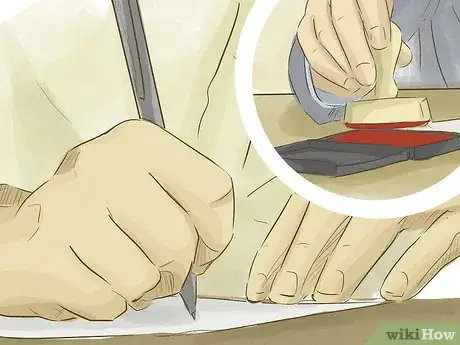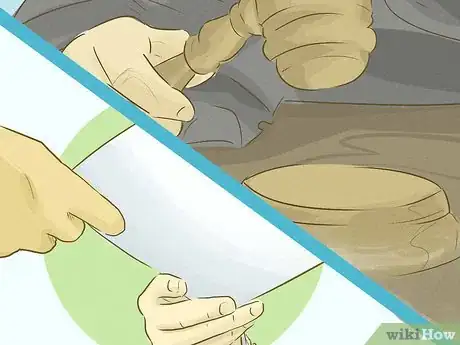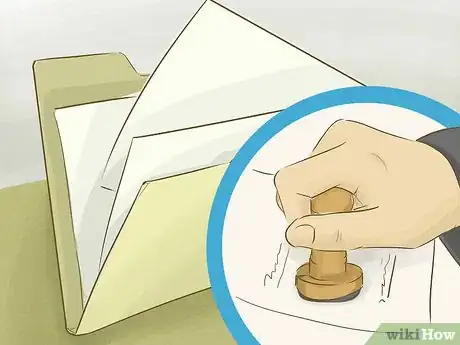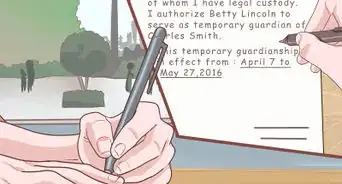This article was co-authored by Clinton M. Sandvick, JD, PhD. Clinton M. Sandvick worked as a civil litigator in California for over 7 years. He received his JD from the University of Wisconsin-Madison in 1998 and his PhD in American History from the University of Oregon in 2013.
There are 8 references cited in this article, which can be found at the bottom of the page.
This article has been viewed 70,936 times.
If your child is living in the state of Ohio and you want custody, you will need to file an action with a court in the state of Ohio. You can ask for custody during a divorce or separation proceeding, or if the you and the other parent are not married to one another and you want to establish a parental relationship with the child. Additionally, you can request temporary custody if the child is in danger living with the other parent.
Steps
Filing for Custody in Divorce or Separation
-
1Create a parenting plan. Child custody is a major issue in a divorce or separation where the couple has children. If both parties can agree to a parenting plan, the court will not have to hold a hearing or trial to determine custody. Talk to the other parent about how best to schedule custody and visitation. Remember to take into account each parent's work schedule and the child's school schedule. For example, if you work during the times that your child is home from school, let the other parent have the child at those times.
- Decide who will get physical custody. Physical custody means that the child primarily lives with that parent. The other parent has visitation rights, and can visit the child or have the child visit him or her.[1]
- Decide who will get legal custody. A parent with legal custody has the right to make decisions about the child's health care, education, and religious upbringing.[2] Both parents can usually share legal custody even if one parent has physical custody.
-
2Talk to a mediator. Try talking with a third party who can act as a neutral negotiator if you and the other parent are having trouble reaching a parenting agreement. Your county may have a court-sponsored mediation program to help parents construct a parenting plan. Ask the court clerk whether your county has a mediation program and how you can schedule mediation with a court-sponsored mediator. If you call the clerk, he or she may be able to refer you to mediation information on the court's website. If you visit the clerk in person, he or she may direct you to a pamphlet with that information.Advertisement
-
3Complete a "Parenting Plan" form. You can find blank Parenting Plan forms at supremecourt.ohio.gov. On the form, write down the details of your parenting agreement. The form will prompt you to enter holiday and vacation schedules. There is also space to arrange for other special events or occasions.[3]
- You can type into the forms before you print them, or complete them in blue or black ink. Follow the included instructions and attach additional pages if necessary.
- If you cannot agree with the other parent on the details of your parenting plan, consult a mediator. If you still cannot come to an agreement, you will need to ask the judge to make a custody determination at a hearing or trial. The judge will hear argument from both sides and try to make a decision that is in the best interests of the child.
-
4File your forms. Make copies of your forms and take them to the court clerk. The clerk will stamp the original and the copies as "filed" and keep the original document for the court's file. The judge will review the agreement. As long as there are no problems, the judge should sign the bottom of the form, making the agreement a court order. Both parents are required to follow the agreement.
- You should submit your parenting plan along with your divorce/dissolution paperwork. The filing fee for a divorce action in Ohio is approximately $250. If you cannot afford to pay the fee, ask the clerk for information on how to apply for a fee waiver. You will be required to provide detailed information about your income and expenses for the judge to review before your waiver is granted.
Filing for Custody When the Parents are Unmarried
-
1Complete a "Complaint for Parentage, Allocation of Parental Rights and Responsibilities (Custody), Parenting Time (Companionship and Visitation)" form. This form is available at supremecourt.ohio.gov. By filling out this form, you can request a parenting plan and child support obligation from the court. You can also request that the court determine whether you are the child's biological father through genetic testing.[4]
-
2Fill out a "Parenting Proceeding Affidavit" form. This form is available at supremecourt.ohio.gov. Enter information about the parties and the child, including the names and addresses. There are boxes you can check to indicate that you would like the information you provided to be kept confidential.[5]
-
3Complete an "Affidavit of Income and Expenses" form. This form is available at supremecourt.ohio.gov. Write in how much money you make and your household expenses. The court will review the information you have provided when making a determination of how much you will owe in child support.[6]
-
4Have your affidavits notarized. Visit a notary a public before you sign your affidavits. The notary will notarize your paperwork, verifying that you signed the document in his or her presence. Bring a valid form of identification, such as a driver's license or passport, so that the notary can verify your identity.
- Most banks have a notary public on staff and do not charge a fee for notary services if you are a bank customer. If you are not a bank customer, you can usually use the bank's notary service for a small fee.
-
5File the forms with your local court. Make copies of your forms and take them to the court clerk. The clerk will stamp them, keep the original, and return the copies to you. The clerk will contact you later to give you a hearing date. The filing fee for a custody action or one for custody and parentage ranges from approximately $115.00 to $190.00. If you cannot afford to pay the fee, ask the clerk how you can apply for a fee waiver.
-
6Serve the other parent. Fill out a "Request For Service" form, which is available at supremecourt.ohio.gov. Give the completed form to the court clerk, who will serve the other party according the method you indicated on the form. You can instruct the clerk to serve the other party by mail, or to arrange to have the sheriff's department serve the other party.[7]
-
7Attend the hearing. At the hearing, the judge will ask you questions about the information you provided on the forms you filed. The other parent will have a chance to argue why he or she might object to you having custody. You can make counter arguments. If you disagree with something the other parent says, do not address him or her directly or interject. Instead, wait for the other parent to finish speaking, then tell the judge your side of the story.
Filing an Emergency Request for a Temporary Child Custody
-
1Fill out an "Verified Motion for Temporary Orders Ex Parte" form. If you believe your child is in danger in the care of the other parent and you cannot wait for a permanent custody order to proceed through the court system, you can use this form to get temporary custody quickly. Use the blank space to explain the dangerous situation that warrants an emergency custody order. The other parent will get some notice of your emergency motion, but the judge can make a decision about your request even if the other parent does not attend.
- Situations that may warrant an emergency custody order include threats by the other parent to harm or kidnap the child[8] , indications of child abuse, or unlawful acts by the parent, such as illegal drug use.
-
2Have your motion notarized. Sign the motion in the presence of a notary public. The notary will notarize your paperwork, verifying that you signed the document in his or her presence. Bring a valid form of identification, such as a driver's license or passport, so that the notary can verify your identity.
-
3Include a "Judgment Entry" form. You can leave this form blank. The judge will fill out the court's orders, including whether you shall have custody of the child, how long the order will last, and whether the other parent is restricted from visiting or having other kinds of contact with the child.
-
4File the forms with your local court. Make copies of your forms and take them to the court clerk. The clerk will stamp them, keep the original, and return the copies to you. The clerk will contact you to give you a hearing date. You may be required to pay a filing fee. Contact the court clerk and ask how you can access your county's fee schedule. If you cannot afford to pay the fee, ask the clerk how to submit an application for a fee waiver.
-
5Attend the hearing. When you return to court for the hearing, the judge will ask you questions about the information you provided in your motion before he or she grants your request. The child's other parent will have the opportunity to deny or explain your allegations of abuse or neglect. Bring any evidence and witnesses you can use to prove that it would be in the child's best interests to be taken from the other parent and placed in your care.
- The court may allow the child to testify at the hearing. A child's competency to testify in Ohio depends upon the age of the child. Children over 10 years of age are generally allowed to testify, while children younger than 10 must be found by the court to be able to understand questions and answer truthfully.[9]
-
6Serve the other parent. Fill out a "Request For Service" form, which is available at supremecourt.ohio.gov. Give the completed form to the court clerk, who will serve the other party according the method you indicated on the form. You can instruct the clerk to serve the other party by mail, or to arrange to have the sheriff's department serve the other party.[10]
Warnings
- The forms referenced in this article are provided by the Ohio court system, but different counties in Ohio may use different or additional forms. To find the forms particular to your county, if any, call or visit the court clerk.⧼thumbs_response⧽
- This article is intended as legal information and does not provide legal advice. If you need legal advice, contact a licensed attorney.⧼thumbs_response⧽
References
- ↑ http://family.findlaw.com/child-custody/types-of-child-custody.html
- ↑ http://family.findlaw.com/child-custody/types-of-child-custody.html
- ↑ http://www.supremecourt.ohio.gov/JCS/CFC/DRForms/Form18.pdf
- ↑ http://www.supremecourt.ohio.gov/JCS/CFC/DRForms/Form20.pdf
- ↑ https://www.supremecourt.ohio.gov/JCS/CFC/DRForms/Affidavit3.pdf
- ↑ https://www.supremecourt.ohio.gov/JCS/CFC/DRForms/Affidavit1.pdf
- ↑ https://www.supremecourt.ohio.gov/JCS/CFC/DRForms/Form28.pdf
- ↑ http://family-law.lawyers.com/child-custody/emergency-temporary-child-custody.html
- ↑ http://www.supremecourt.ohio.gov/LegalResources/Rules/evidence/evidence.pdf










































































